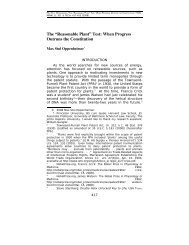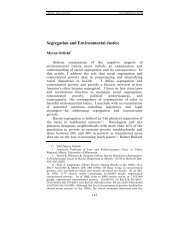An Organizational Approach to the Design of Patent Law
An Organizational Approach to the Design of Patent Law
An Organizational Approach to the Design of Patent Law
You also want an ePaper? Increase the reach of your titles
YUMPU automatically turns print PDFs into web optimized ePapers that Google loves.
6 VERTINSKY FINAL_JAD (DO NOT DELETE) 2/27/2012 2:20 PM<br />
2012] AN ORGANIZATIONAL APPROACH 265<br />
sarily incomplete or information is imperfect. 233 The potential<br />
for costly opportunism is particularly severe where assetspecific<br />
or relationship-specific investments are required in <strong>the</strong><br />
face <strong>of</strong> imperfect information and high transaction costs. <strong>Patent</strong><br />
laws should <strong>the</strong>refore be designed <strong>to</strong> reduce situations <strong>of</strong> incomplete,<br />
particularly asymmetric, information, and <strong>to</strong> reduce<br />
<strong>the</strong> cost and uncertainty <strong>of</strong> establishing <strong>the</strong> boundaries <strong>of</strong> patent<br />
rights. A number <strong>of</strong> patent reform proposals that have received<br />
attention by commenta<strong>to</strong>rs and policy-makers can be explained<br />
and justified in light <strong>of</strong> this approach.<br />
For example, <strong>the</strong> organizational approach provides a justification<br />
for Lemley’s and Kimberly A. Moore’s proposal <strong>to</strong> restrict<br />
<strong>the</strong> ability <strong>to</strong> file continuation patent applications, which<br />
allow patent applicants <strong>to</strong> abandon and re-file applications or<br />
<strong>to</strong> keep applications on file while pursuing related applications<br />
on <strong>the</strong> same invention. 234 Continuations can create problems<br />
such as introducing delay and uncertainty for competi<strong>to</strong>rs because<br />
<strong>the</strong>y must guess about pending claims, obtaining broader<br />
patents due <strong>to</strong> persistence ra<strong>the</strong>r than merit, and using <strong>of</strong> strategic<br />
practices <strong>of</strong> drafting claims that cover competi<strong>to</strong>r products<br />
or surprising established producers who are unaware <strong>of</strong> <strong>the</strong><br />
pending application.<br />
The organizational approach similarly supports James<br />
Bessen’s and Michael J. Meurer’s call for improving <strong>the</strong> notice<br />
function <strong>of</strong> patents by increasing <strong>the</strong> transparency <strong>of</strong> <strong>the</strong> patent<br />
process and <strong>the</strong> predictability and visibility <strong>of</strong> patent boundaries.<br />
235 These efforts help <strong>to</strong> increase <strong>the</strong> information that economic<br />
ac<strong>to</strong>rs have before <strong>the</strong>y make project-specific or relationship-specific<br />
investments and improve <strong>the</strong> ability <strong>of</strong> patents <strong>to</strong><br />
perform effectively as property.<br />
The organizational approach is <strong>of</strong> particular assistance in<br />
guiding responses <strong>to</strong> patent trolling, since <strong>the</strong> practice involves<br />
233. See Williamson, Transaction Cost Economics, supra note 144, at 30–<br />
31.<br />
234. Mark A. Lemley & Kimberly A. Moore, Ending Abuse <strong>of</strong> <strong>Patent</strong> Continuations,<br />
84 B.U. L. REV. 63, 64–66 (2004) (describing <strong>the</strong> harm caused by<br />
abuse <strong>of</strong> continuations practice and proposing restricting, or even abolishing,<br />
continuation practice).<br />
235. BESSEN & MEURER, supra note 22, at 7 (“The economic effectiveness <strong>of</strong><br />
any property system depends not just on what it sets out <strong>to</strong> do, but also on <strong>the</strong><br />
laws, regulations, institutions, and norms that implement <strong>the</strong> system.”).<br />
Bessen and Meurer also argue that an effective property system must improve<br />
<strong>the</strong> implementation <strong>of</strong> patent laws in a way that satisfies <strong>the</strong> notice requirement<br />
<strong>of</strong> property rights. Id. at 235–36.






